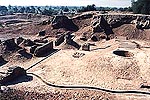

Harappa
A major center of the Indus Valley Civilization was Harappa whose ruins lie 35-km southwest of Sahiwal (about 250 km from Lahore). This was the first of Indus Valley Civilization sites to be discovered.
Situated besides an earlier course of the Ravi River, Harappa was discovered in 1920-21. The area of Harappa is bigger than Moenjodaro but much to the remains above ground were ravaged by brick-hunters using the material as blast when the railway tracks between Lahore and Multan were laid. However, several cemeteries, which escaped the attention of vandals, have been excavated to reveal the richness and sophistication of its culture.
Like Moenjodaro the excavations have revealed a series of cities, stacked one upon another. The site, with its citadel and great granary, seems similar in many ways to Moenjodaro and like its southern sister-city appear to have thrived around 2000 to 1700 B.C. with an economy based largely on agriculture and trade. The Harappan society seems to have been egalitarian, pursuing a rather simple way of life. The cemeteries discovered at Harappa confirm that the Indus Valley people buried their dead, many of them wearing finger rings, necklaces of steatite beads, anklets of paste beads, earnings and shell bangles. Copper mirrors, antimony rods, shell spoons and vessels and urns of various shapes and size lay in the graves. Some of the female skeletons had anklets of tiny beads and girdles studded with semi-precious stones.
Excavations have recalled evidence of some pre-Harappan material, which shows strong affinity, with some Kot Diji finds. On display at the Museum is excavated material, including terracotta toys, gamesman, and jewelry, animal figurines, bronze utensils statuettes etc. Harappa and Moenjodaro are two places which form the focal point of tourist attraction. So if you are in Pakistan do'nt miss these historical journeys. You'll be facinated by the displays and exotic archeological finds!











comment:
p_commentcount